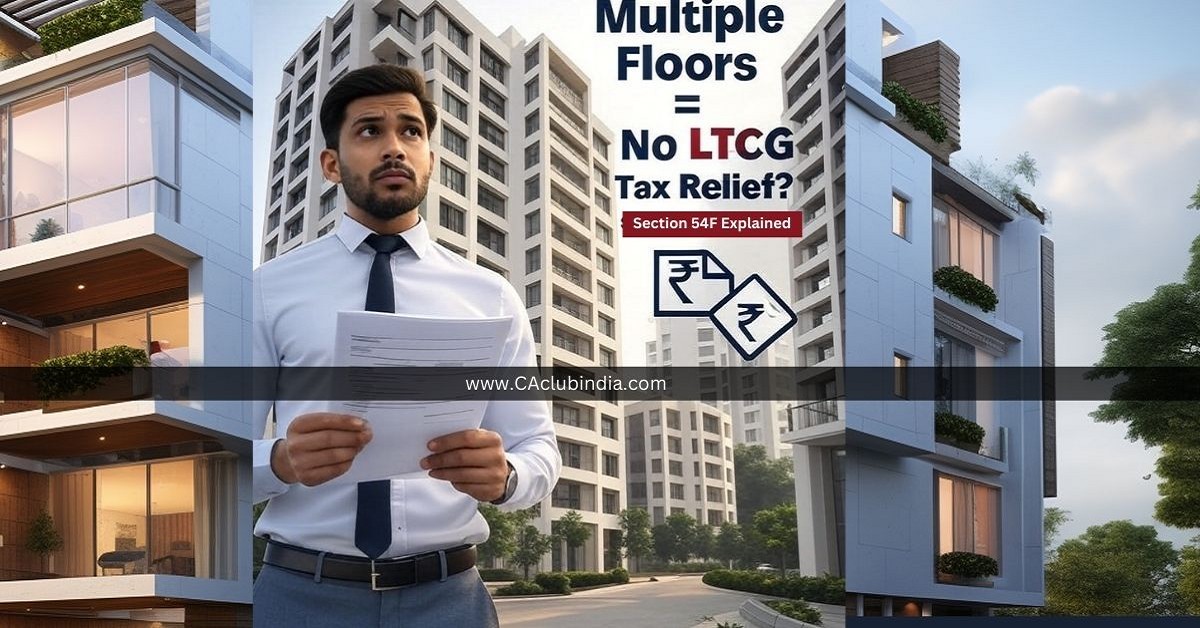Introduction
The Delhi High Court has recently clarified a long-debated issue in tax law - does owning multiple floors in the same residential building mean you own more than one residential property?
This question is crucial for taxpayers looking to claim the long-term capital gains (LTCG) exemption under Section 54F of the Income Tax Act. The answer, as per the Court's ruling, could bring relief to many homeowners across India.

What Does Section 54F Say?
Section 54F offers a capital gains exemption when you sell a long-term capital asset (e.g. shares, land, intellectual property) and use the proceeds to purchase or construct a residential house.
Key Conditions
- The new house must be purchased within 1 year before or 2 years after the sale, or constructed within 3 years.
- On the date of sale, you should not own more than one other residential house apart from the new one being bought.
- The entire net sale consideration must be invested, or the exemption is allowed proportionately.
What Was the Controversy?
The confusion arises when someone owns multiple floors in the same building. Are these floors considered separate houses, or is it still one residential house?
This was exactly the issue in a case involving a Delhi taxpayer, where the Assessing Officer (AO) denied the full Section 54F exemption, claiming that the taxpayer owned multiple residential houses (i.e., different floors).
Delhi High Court's Ruling
The Delhi High Court clarified:
"We find it difficult to accept that, in the given facts, different floors of a house are required to be considered as multiple residential houses."
Key Takeaway:
Ownership of multiple floors in the same building does NOT mean you own multiple houses - provided the structure is capable of being used as one residential unit.
The Court upheld that as long as the floors:
- Are part of one cohesive building
- Share the same municipal address
- And are used (or are capable of being used) as a single home
They will be treated as one residential house for the purpose of Section 54F.
Case Summary: Lata Goel vs. Income Tax Department
- The taxpayer claimed a Rs 90 crore exemption under Section 54F from gains earned via share sale.
- AO restricted it to Rs 30 crore, citing improper reinvestment and multiple property ownership.
- CIT (Appeals) allowed the full exemption, which was later upheld by ITAT and finally the Delhi High Court in 2025.
Implications for Homeowners
This ruling offers relief and clarity in situations like:
Example 1: One Building, Multiple Floors
If a person owns Ground, First, and Second floors of the same house - it will be treated as one residential house, even if family members co-own different floors.
Example 2: Two Different Buildings
If you own one floor in Building A and another floor in Building B - even if both are partial units - it will be counted as two separate houses. In this case, you will not qualify for exemption under Section 54F.
Can Co-Owners Claim Exemption Under Section 54F?
Yes. When two individuals jointly invest in a residential house using proceeds from their individual capital gains, both can claim Section 54F exemption - in proportion to their investment.
Example:
- Mr. A sells shares worth Rs 50 lakh
- Mrs. B sells shares worth Rs 25 lakh
- They jointly buy a house worth Rs 75 lakh
Outcome:
- Mr. A gets an exemption of Rs 50 lakh
- Mrs. B gets an exemption of Rs 25 lakh
If the investment is not 100% of the capital gains, the exemption is allowed proportionately as per the following formula:
Exemption = Net Consideration Invested / Net Consideration Received × Long-Term Capital Gain
Conclusion
This Delhi High Court ruling is significant. It:
- Aligns tax interpretation with real-world residential arrangements
- Prevents undue hardship for homeowners with vertical extensions
- Ensures that tax exemptions under Section 54F are not unfairly denied due to technicalities
For homeowners, investors, and tax professionals, the message is clear: focus on the functional use and structure of the property, not just the number of registries or floors owned.








 CAclubindia
CAclubindia
